IME Publishes Database on Local Taxes and Fees
The published database covers not only 2012, but previous years as well.
The published database covers not only 2012, but previous years as well.
IME Publishes Database on Local Taxes and Fees
In the spring of 2012 IME sent questionnaires to all 264 municipalities in the country. Our goal was to collect official information on the rates of local taxes and fees as well as on the development of e-services and one-stop-shops. The process of collecting the data, contained in the nearly 200 replies received from municipalities required no less than three months.
The data includes the rates of immovable property tax for legal entities, vehicle tax, license tax for retailers, waste collection charge for properties of legal entities, fee for the use of industrial goods markets per day, as well as the municipalities’ self-assessment of the quality of e-services supply and their degree of readiness regarding one-stop-shops.
The data presented here covers not only 2012, but previous years, too. Our comment on this data can be found in a thematic analysis, titled “Local Tax Policy”. The data was used for assessment of regional business environment, too.
In 2013 IME will once again send questionnaires to all municipalities in order to update the database. This year’s goal is to cover all the 264 municipalities in the country. We are looking forward to cooperating with the local authorities on this particular initiative.
The database is available in xlsx format here as well as on our data-related internal web page.
The project “Regional Profiles: Indicators of Development” is carried out with the financial support of the America for Bulgaria Foundation.
A more comprehensive review of the state of the labor market on a regional level reveals troubling trends in certain regions.
Yavor Alexiev
In the past few years, the state of the labor market in Bulgaria is mostly defined by:
A more comprehensive review of the state of the labor market on a regional level reveals troubling trends in certain regions.
To demonstrate these trends, we will divide the last ten years, of available regional labor market data in two periods. The first period is the pre-crisis years between 2002 and 2008, and the second one – the crisis years between 2008 and 2011.
The acceleration of economic activity in Bulgaria during the pre-crisis years is not an even process – the rise in overall employment leads to a widening �of the gap between Bulgaria’s regions.
The main factor for this process is the economic and demographic development of Sofia (capital). In the pre-crisis period the average employment in the country was rising because of the new jobs created in the capital. Employment in certain smaller districts such as Dobritch, Pazardzik, Smolyan and Yambol also rose rapidly before 2008, but a main reason for the latter is the drop in overall population in these regions as well as the small employment base in the beginning of the period. The effect of the increase of employment in these districts on the country average is quite negligible.
Regional employment in 2002 and 2011
In 2002. there are nine regions where the annual average employment is higher than the country average. In four of them – Blagoevgrad, Varna, Kardzhali and Sofia (capital) annual employment exceeds the standard deviation for the country.
Graph 1: Employment rates in the population above 15 years of age (2002), %
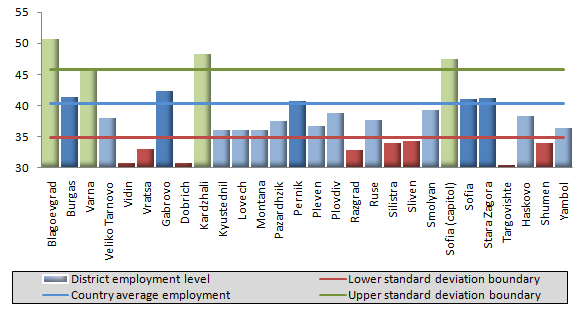 �
�
Source: IME calculations based on NSI data
By the end of 2011 the regions where employment rate is higher than the country average are only five, while in two of them – Blagoevgrad and Sofia (capital) – employment is higher than the upper boundary of the standard deviation (Graph 3). This occurs against the background of an increasing annual average employment in the economy – from 40.3% in 2002 up to 45.6% in 2011.
Graph 2: Employment rates for the population aged 15 years and above (2011), %
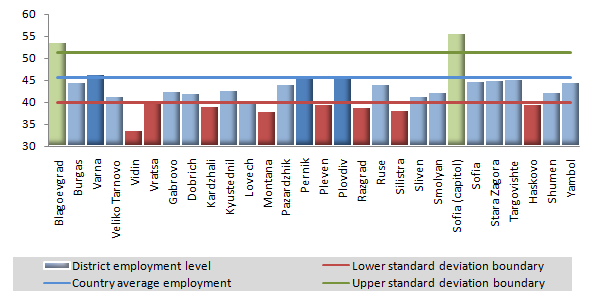
Source: IME calculations based on NSI data
Sofia (capital) and Blagoevgrad have managed to keep their leading positions in employment levels. Employment in Blagoevgrad and in the capital is the highest in 2002 as well as in 2011. Sofia (capital) has kept its leading position due to its high economic activity, Blagoevgrad – due to its good business environment and partially due to its proximity to the capital. Pernik, Plovdiv, Sofia and Stara Zagora also perform well. In the same time, employment in the bigger regions like Burgas, Stara Zagora, Gabrovo and Sofia increases at slower rates than the country average and has fallen below the country average in 2011.
Graph 3: Dynamics of employment in the pre-crisis and crisis periods, p.p.
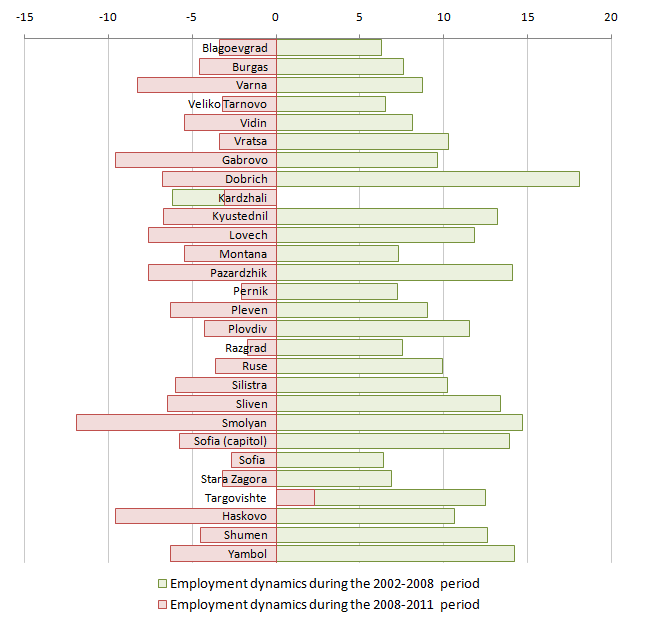
Source: IME calculations based on NSI data
As it can be seen on Graph 3, Targovishte is the only region in the country where employment rises in the end of both periods, respectively from 30.6% in 2002 to 43.1% in 2008, an later on up to 45.40% for 2011. Even though the highest employment rates are recorded in 2009 (45.6%), the crisis has a negligible effect on employment in the district compared to the other regions of the country. In the past 10 years Targovishte has turned from the district with the lowest employment rate in the country into the one with the sixth highest employment, reaching levels close to the country average. Among the main reasons for the region’s good performance are the low base at the beginning of the period, as well as the improving business environment, which has helped attract investment.
Kardzhali features as exactly the opposite case. The district is the only one which shows a drop in the employed population both during the crisis and in the previous period. An interesting fact is that in 2002 employment in Kardzhali is higher than that in the capital, with only employment in Blagoevgrad reaching higher levels. Despite that, in the past 10 years it has dropped by almost 10 percentage points, which leaves it well under the country average in 2011.
When it comes to employment, the crisis has destroyed all positive employment developments in Haskovo, Smolyan, Gabrovo and Varna.
What can happen in 2013?
The gap in economic activity between the regions is likely to grow bigger in the upcoming period. This is based on the negative demographic trends, relatively low foreign investment and increasing social security burden. The latter in particular has a negative effect on smaller districts, where due to lower economic activity and the limited local markets, wages in many spheres of the economy are close to the minimum �social security thresholds.
In the same time, the dynamics of the labor market in Kardzhali and Targovishte shows how important the efforts of the local administration are for the development of a better business environment. It is exactly the favourable business environment that increases the investment attractiveness of a district, which leads to an increase in economic activity and new jobs.
The project “Regional Profiles: Indicators of Development” is carried out with the financial support of the America for Bulgaria Foundation.
The recently published study “Regional Profiles: Indicators of Development 2012” has already caught the attention of policy makers and is being used in the preparation of strategic documents and reports.
The recently published study “Regional Profiles: Indicators of Development 2012” has already caught the attention of policy makers and is being used in the preparation of strategic documents and reports. The results of the study have been quoted in this year’s�report�on management of EU funds, presented by the Parliamentary Committee on European Affairs and Oversight of European Funds.
The study has also been used in the preparation of some of the recommendations of the Committee on improving the allocation and utilisation of EU funds during the next programme period (2014-2020).
The project “Regional Profiles: Indicators of Development” is carried out with the financial support of the America for Bulgaria Foundation.
Is the domination of different economic branches a factor when it comes to poverty levels or wealth in the region?
* Stoyan�Hristov
During the analysis of regional development, an interesting question arises: is the domination of different economic branches a factor when it comes to poverty levels or wealth in the region? In order to be able to answer this question, we are going to use data from the recently published survey “Regional Profiles – Indicators for Development”.
One of the ways to explore whether such a link exists is to use the gross value added (GVA) of each branch in the districts. The data for 2009 (the most recent data available) shows that the sector of services accounts for the largest portions of GVA in 24 of the regions. In the remaining four – Sofia district (62%), Stara Zagora (58%), Gabrovo (48%) and Vratsa (46%) – the leading branch is industry. In regions where large cities are present the trend is for services to take the largest part; here the city of Sofia features as leader with its services branch amounting to almost 79%, followed by Varna where services hold 68.6%.
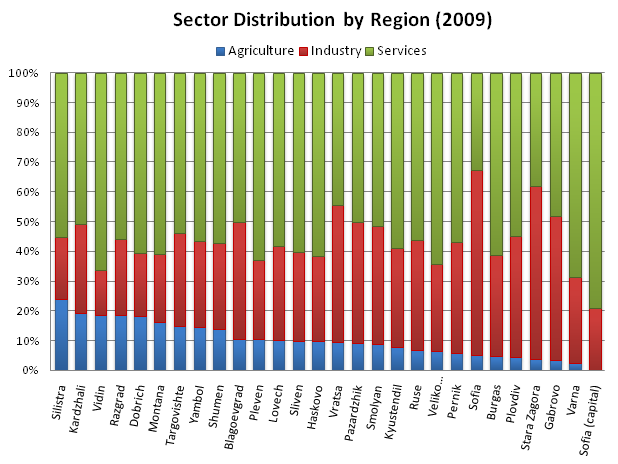
Source: NSI
As expected, according to the data, agriculture makes for a rather small portion of GVA in all regions and the country as a whole. The next graph shows the interconnection between the size of the agricultural branch and the economic development of the region.
The main indicator for the degree of regional development is GDP per capita. The following graph shows the reverse relation between GDP per capita and the share of the agricultural branch in the economy of the region[1]. Given this negative trend, two separate groups stand out. The first group is comprised of regions with relatively well-developed agricultural branch and a GDP per capita lower than the country average. The second one encompasses regions with relatively underdeveloped agriculture and a GDP above the country average.
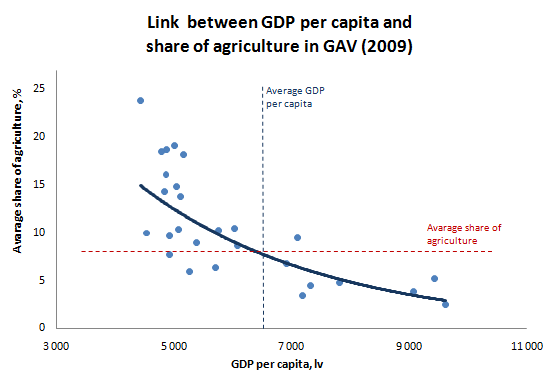
Source: NSI
This leads to two separate conclusions. The data show that regions with a higher portion of agriculture in their GVA – above the country average – have relatively weaker economies. Examples for this are regions like Silistra, Vidin and Razgrad, which have a relatively large agricultural branch and feature a rather bad economic state and negative demographic trends[2]. On the other hand, the number of regions in this first group is bigger. Put in other words, these are the less populated areas, which fall behind according to a big number of indicators. If we compare these data with the “Regional Profiles: Indicators of Development” survey, we will reach the same conclusion. The average score in the “Economy” indicator is “unsatisfactory” for the first group and “good” for the second one.
On the other hand, the economically well-developed regions have a relatively underdeveloped agricultural branch – below the country average. There is only one exception – Vratsa region – and even there the share of agriculture is above 14 per cent lower than the leader in this respect – Silistra. In other words, the most developed regions in Bulgaria, according to the majority of indicators, fall in the second group. According to IME’s survey, these regions are also the ones with the best environment for business development (Stara Zagora, Targovishte); they also have the best socioeconomic state (Bourgas, Varna, Plovdiv) and have the most promising development trends (Ruse, Sofia).
Does this all mean that the population of these regions is poorer? The results depend on how we define poverty: 1) As an absolute indicator (income) or 2) as the standard of living above the poverty level. The first option covers what we had just shown – the economic development of the regions – and the results are fairly similar. NSI provides us with a second option. If we look at the poverty and social inclusion indicators we are bound to notice that there is a connection – albeit not a strong one – between the relative share of the agricultural branch and the poverty line. The graph below shows that with an increase of the share of the agricultural branch the poverty line drops lower[3]. This is to say that a lower income is necessary to maintain a standard of living above the poverty line in these regions – the standard of living there is lower. Despite that fact, if we consider the share of the population living below the line of poverty, we will see that these numbers cannot be linked to the size of the agricultural branch.
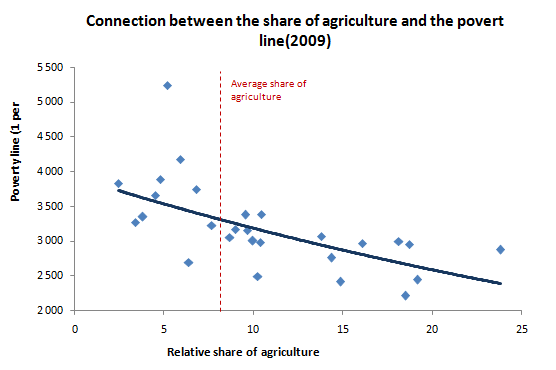
Source: NSI
To summarize, we can safely say that despite the small share of the agricultural branch in Bulgaria it is obvious that it is inversely related to the socio-economic development of the regions. However, when it comes to poverty, this link cannot explain why certain regions are poorer than others or why the number of poor people is bigger. Still, we can state that in the regions with a better-developed agricultural branch the poverty line is lower, which is an indicator for the standard of living in these regions.
*The author is an intern at IME
Almost a month after the publication of the Bulgarian edition of the study “Regional Profiles: Indicators of Development 2012”, it continues to be the subject of high interest among Bulgarian media, as well as among different groups in the government and nongovernmental sector.
Almost a month after the publication of the Bulgarian edition of the study “Regional Profiles: Indicators of Development 2012”, it continues to be the subject of high interest among Bulgarian media, as well as among different groups in the government and nongovernmental sector.
A few days ago the website Economy.bg published extensive video coverage of a forum, titled “Possibilities and Challenges of Doing Business in the Gabrovo Region”, organized by Economy.bg and Jobs.bg. IME’s senior economist, Petar Ganev, took part in the debates, where he had the chance to present the study’s results, alongside Bulgaria’s minister for EU funds management, and the economist Georgi Stoev (Industry Watch).
Additional information about the research was published on the international portals 4liberty.eu and Stockholm Network.
The full media coverage of the study is available here.
The project “Regional Profiles: Indicators of Development” is carried out with the financial support of the America for Bulgaria Foundation.
Here you can find links to the scanned copies of articles that some of the leading Bulgarian newspapers dedicated to the study.
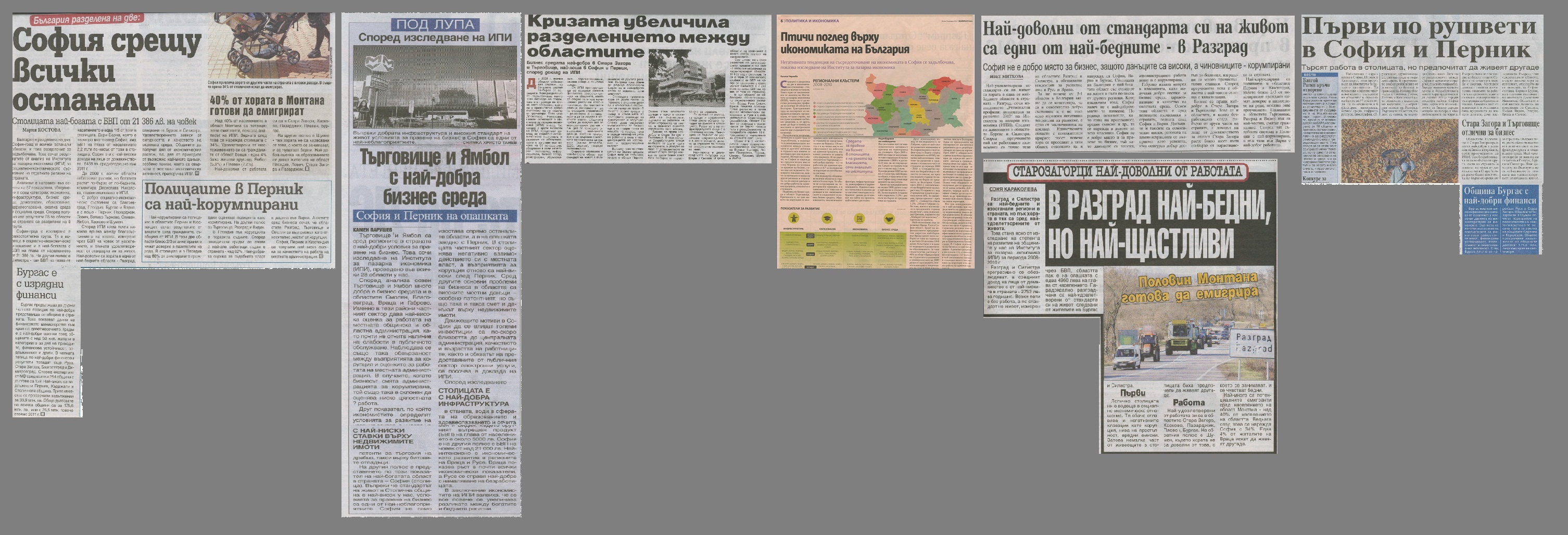
Here you can find links to the scanned copies of articles that some of the leading Bulgarian newspapers dedicated to the study.
The full media coverage of the study is available here.
The project “Regional Profiles: Indicators of Development” is carried out with the financial support of the America for Bulgaria Foundation.
The English version of regionalprofiles.bg was launched on December 3rd.
Тhe English version of the website, dedicated to IME’s study, "Regional Profiles: Indicators of Development",has just been launched.
You can download the full report here, or you can check out the English version of the website by selecting the button in the top right corner of each page.
All statistical data, district profiles, methodological notes, news and thematic analyses are available in English as well.
---
The goal of IME's team is to make all data and analyses understandable and useful for foreign investors, entrepreneurs and other stakeholders.
The availability of detailed information about the characteristics, condition and prospects of the regions of our country are an important prerequisite for the promotion of investment and the increase of transparency and accountability of public policies at the local level.
The project “Regional Profiles: Indicators of Development” is carried out with the financial support of the America for Bulgaria Foundation.
REGIONAL AWARDS: Who is the most of the most among the regions 14.12.2025
For more than a decade, the Institute for Market Economics has been presenting the publication "Regional...
It's not just Sofia: where are the highest incomes and investments in the country 01.12.2025
In this year's edition of the IME study "Regional Profiles: Indicators of Development " 2025, the capital...
Almost full health insurance coverage, what next 17.11.2025
The share of the population with health insurance at the national level is growing and exceeds 95%, which to...
Regional Profiles 2025": persistent polarization between leading urban centers and peripheral areas 12.11.2025
"Regional Profiles: Indicators of Development 2025" summarizes the current statistics for the 28 regions and...